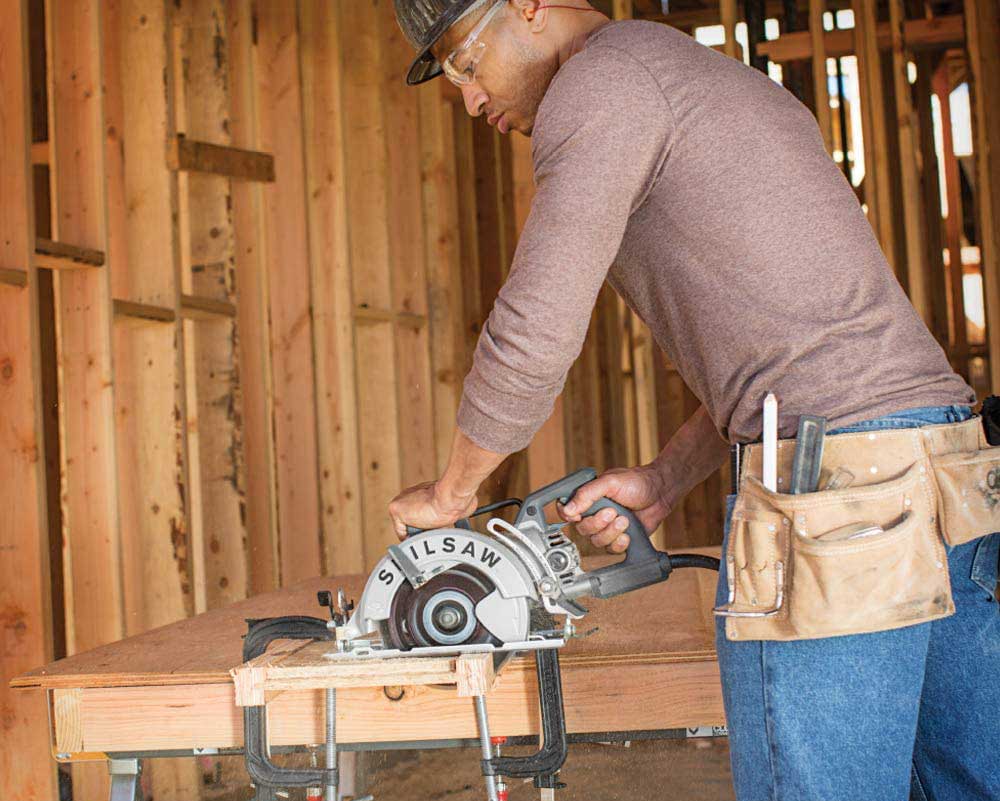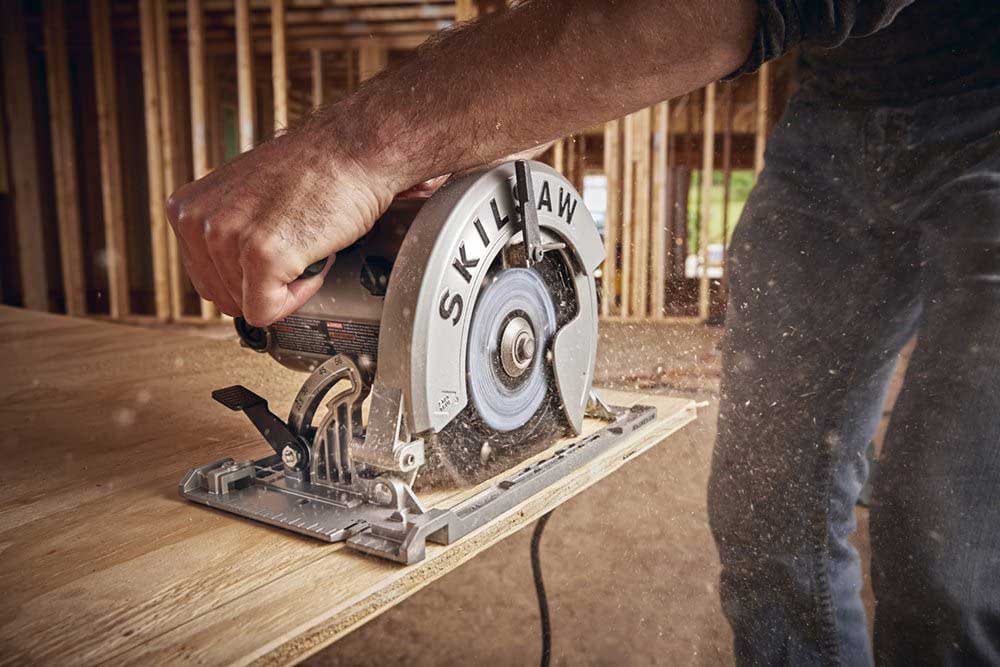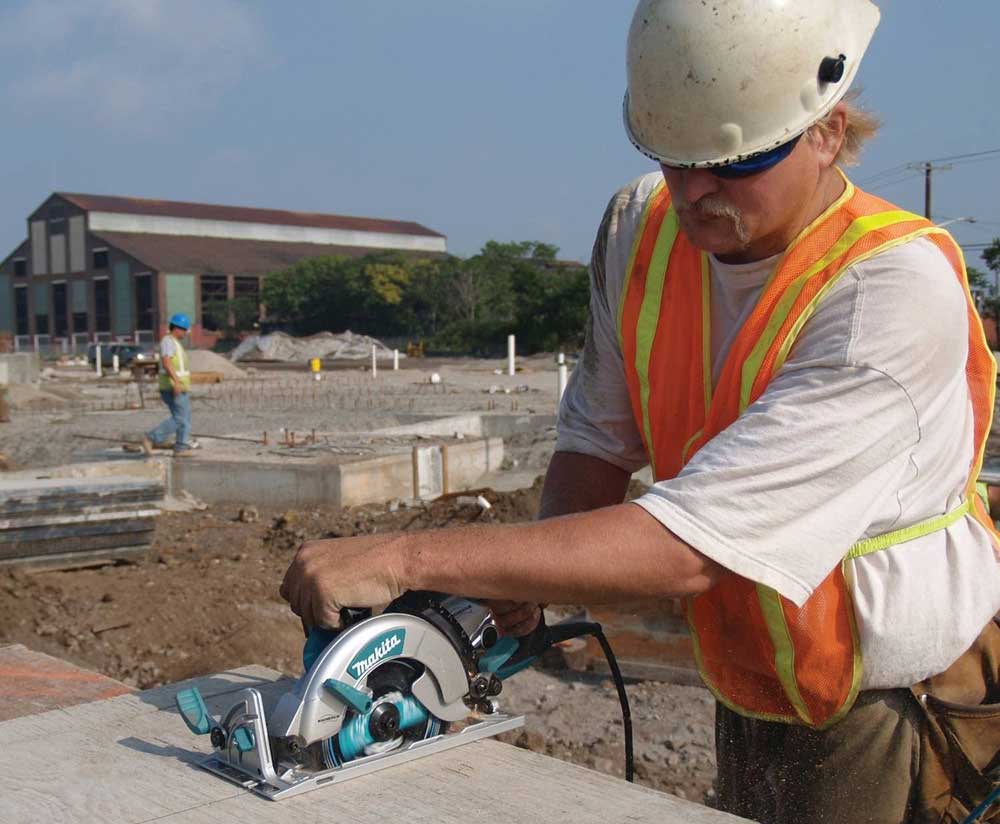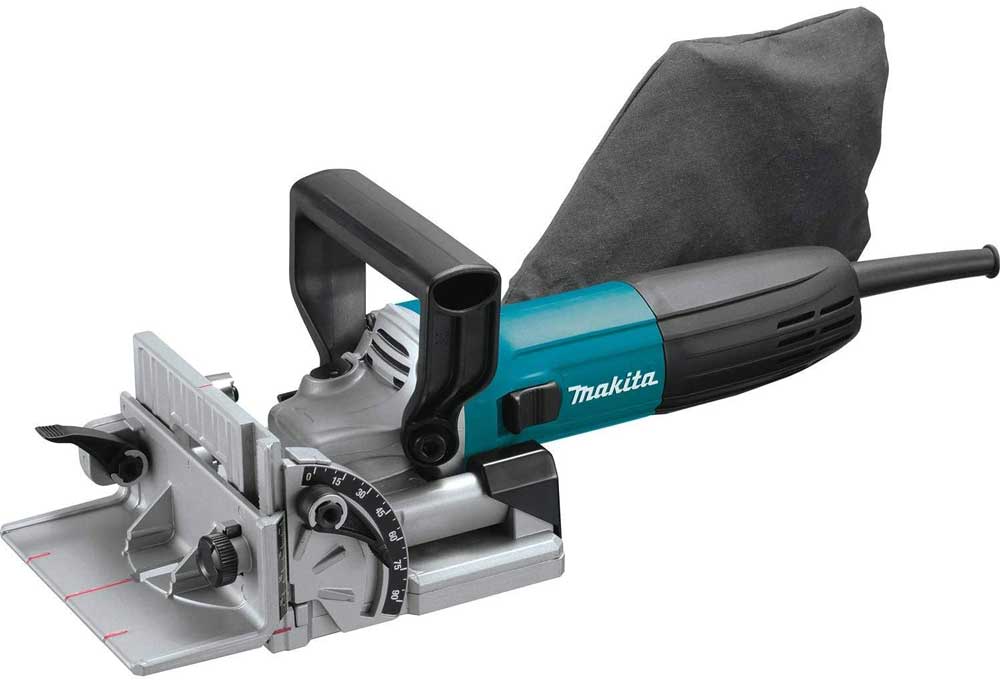A circular saw is one indispensable tool of the woodworking world. Whether you want to make long rip cuts, bevels, miter cuts, or other types of cuts, a circular saw saves you a great deal of work. What’s more, they are usually economical and portable, giving you the convenience you need in your operations.
However, it’s worth noting that we don’t have one-type-fits-all circular saws in the market. I mean, each type of saw has a different use. To make the most out of these saws, you need to match each kind with the work it does the best.
Unfortunately, it isn’t easy to tell which subcategory of circular saw works best for what type of job. However, after you read our article on 11 different types of circular saws, it’s easy to know the right type for you.
11 Different Types of Circular Saws
1. Worm Drive Circular Saws

We begin our list with the worm driver circular saw. It is one of the most common types we have out there. In fact, if you are a woodworker, chances are that you have it in your shop, or you have interacted with it in the past.
A worm drive circular saw is similar to a sidewinder circular saws. However, there are a few differences that distinguish the two. The variance, in this case, is based on the positioning of the motor and how each transfers power to the gears and then to the blades.
The motor of a worm drive circular saw is at the rear of the tool. That means the power is transferred from the motor to the blade through the gears. This design generates better torque, however at the expense of suppressed blade speed.
A worm drive circular usually comes with a blade on the left hand-side, leaving most of the weight to the right hand-side. The positioning of the blade to the left allows the right-handed users to see it when cutting. While lefties can still use this tool, they will need to bend their heads a little to follow a cut line. These saws are ideal for bevel cuts, longer cross, miter cuts, and more.
2. Sidewinder Circular Saws

The sidewinder circular saw is another type of saw you are likely to find in most shops. In this type of saw, the motor is in line with the blade, and that’s why they are at times called in-line circular saws. The in-line configuration makes this saw shorter and fairly compact than the preceding rival.
Also, the positioning of the motor eliminates the need for gears, ensuring more efficient transfer of power to the blades. For this reason, sidewinder circular saws typically have a higher RPM rating compared to the worm drive circular saws.
Usually, the blade in this case is at the right of the tool whereas the motor is in the opposite side. That means if you are a lefty, you will find a sidewinder circular saw more comfortable to use, especially if you want an unobstructed sightline to the blade when cutting. While this design is a bit uncomfortable for the right-handed users, it is way safer for them as it keeps both hands far from the spinning blade.
In terms of use, there are many areas where you will appreciate the performance of a circular saw. You can use them for making vertical cuts, overhead cuts, rip cuts, and many other applications.
3. Hypoid Circular Saws

A hypoid circular saw looks exactly like the worm drive version. Among the similarities between the two models is that the motor is located behind the blade, and that’s why it’s also longer and slimmer than the sidewinder circular saw. Also, the blade in this case is usually on the left hand-side of the tool, which makes it more convenient to use for the right-handed persons. Those are just a few of the many features they share.
On the differences, what sets these saws apart is almost entirely mechanical—the gear alignment and the transmission system. The design of the hypoid gears provide improved gear teeth contact, unlike the worm drive gearing system where the teeth aren’t designed to interlock as precisely. That means there’s less energy lost due to friction in hypoid saws, making them more efficient than the counterpart. For this reason, hypoid circular saws outshine their rival in big projects that require a huge amount of torque.
Another difference between the two types of saws is that the hypoid versions don’t require oiling since their motors are completely sealed. That makes them easier and less costly to maintain. In a nutshell, a hypoid saw is a more powerful version of the worm drive that’s easier to maintain.
4. Compact and Mini Circular Saws
No products found.
This type of circular saw is exactly what it claims to be—it is the most compact type of circular saw. The small size makes them ideal for use in tight spaces where the larger versions can’t fit. The compact design also means that they are more comfortable to wield for extended periods. In fact, if you want a type of saw for prolonged use with minimal fatigue, no other kind will serve you better than the compact and mini circular saw.
What the majority of DIYers and professional woodworkers like most about compact and mini circular saws is that they are lighter, making them more convenient to haul than the full-size versions. Most of these saws work for different types of materials. You can use them for making a wide variety of cuts including bevel cuts.
On the downside, the blade of this option has a smaller diameter. Hence, these saws aren’t ideal for cutting thicker materials. Moreover, the smaller size of the cutter also means it will take them more time when making longer cuts. For this reason, the compact and mini circular saws work better for DIY projects and lighter commercial applications.
5. Biscuit Joiners

A biscuit joiner works ideally in joining two pieces of wood without leaving any visible nail holes or other joiners. These tools have a complex system to which a circular saw is a component, and that’s why we consider them as a type of circular saw.
A saw of this class works by cutting slits in the two different pieces of wood and connects them using glue and an oval-shaped third piece that’s called the “biscuit.” Therefore, a biscuit saw will come in handy in cabinetmaking and other woodworking applications that require you to join two pieces of wood.
The size of this saw is more compact and lighter than the standard options, and that’s why it’s less strenuous to work with for long periods. However, before you buy this type of circular saw, there are a few things you should know. For instance, it’s a specialized tool. Therefore, other than joining two pieces of wood, you can’t use it for any other job.
Additionally, since it doesn’t work like the other versions, a biscuit saw will require a little of skill to make the most out of them. But all in all, it makes a decent investment for hobbyists and professionals whose projects require them to combine multiple pieces of lumber without leaving a noticeable joint.
6. Abrasive Circular Saws
No products found.
While the standard saws use blades that have teeth, this subcategory utilizes a special type of flat blade called the composite friction disc. That explains why for years there’ve been a hot debate on whether it should be enlisted along other types of circular saws.
The composite friction disc of this saw is perfect for use on cutting hardest materials like metal, concrete, tiles, and others of the kind. Due to heavy use, the blades of this saws will by default wear out faster than those of other saws. However, with super-abrasive diamond and cubic boron nitride versions now available in the market, there is little to worry about.
When choosing an abrasive circular saw, you have to be considerate of the model you choose. For materials such as concrete, pipe, and asphalt, a handheld version should work just fine. However, for heavier and harder materials like metals and tiles, you may need to acquire a tabletop version.
In terms of configuration, the main components like the handle and motor are closer to the user while the blade is at the far end.
7. Concrete Circular Saws
No products found.
Although they have “concrete” in their name, that’s not the only material you can cut using these saws. Normally, most of concrete circular saws will work well for other materials like metal, brick, asphalt, tile, and more.
The design of the blade is somewhere between that of the abrasive versions and the standard models. I mean, instead of entirely coming without teeth like the abrasive variety, the blade here comes with special type of serrations that are usually tipped with super-tough industrial diamond.
Like the abrasive subcategory, concrete circular saws are available in handheld and chop-saw versions. The motors are also of different types—electric, hydraulic, pressurized, and gasoline, so ensure that you pick the one that’s more convenient for you.
The major drawback here is that cutting with this saw generates much friction. That causes the blade to heat up. Therefore, you may need to use it in short bursts. However, if you want it for larger projects, it allows you to use a coolant. What’s more, you don’t need any special type of coolant as water works incredibly well.
8. Metal Circular Saws
No products found.
Although many saws can work well for metal cutting, using one that’s conceived with the specific job in mind will most of the times yield better results. The metal circular saw is engineered to suit use for metals, although you can also use it across a variety of other materials.
Since metal cutting produces sparks and shards, the design of this circular saw provides an enhanced level of protection to the user. It is also more powerful than most circular saws given that metal is tougher than the majority of other materials.
Surprisingly, even with their enormous amount of power, metal cutting circular saws are more compact than most counterparts. That puts them in the class of “small and mighty” circular saws. The more manageable size is more convenient to transport and to work with for large projects that require more time.
Unlike most materials, metal cutting works best with a lower speed. Reduced speed translates to lower friction and minimal chances of overheating. That’s why we don’t see the reduced cutting pace of this metal cutting circular saw as a downside, as it delivers incredible results when using it for its primary purpose. However, for materials like plywood that require a higher speed, you will appreciate the faster models.
9. Carbide Circular Saw
No products found.
This type of circular saw obtains its name from the material of the blade. In other words, the teeth of the saw in this case are of cemented carbide. This material is incredibly strong, and that’s why this type of saw works ideally for cutting the most rigid materials where most saws may not function as superbly as you would want.
While you can use it for regular woodworking applications, it’s overly aggressive than necessary when utilizing it for softer applications. However, if you want it for cutting hard metals and hardwood, you will appreciate how smoothly it gets you over what would have otherwise been challenging jobs.
A carbide circular saw can either be classified as horizontal, vertical, and pivot. Horizontal versions are also called billet saws and top the list of popularity. In this set up, the blades are at the top of the gearbox. Vertical versions let you stack your material, a feature that comes in handy when you want to cut more than workpiece at once. The pivot version will allow you to use it as a billet saw or layer saw depending on what comes your way.
10. Flip-Over Circular Saws
No products found.
Have you ever thought of having a single unit that can do what a table saw can when also allowing you to utilize it as a miter saw? Well, if you’ve imagined of such a tool before, this type of saw works exactly that way.
A flip-over circular saw is a hybrid version of a miter saw and a table saw. Therefore, with this type of saw, you can do everything you can achieve with either of the two parent versions. That’s why we see it as one of the most versatile circular saws in the market. Whether you want to make precise angled cuts like those of a miter saw, rip boards apart, or whatsoever kind of job, there really isn’t much that you can’t do with a flip-over circular saw.
All flip-over circular saws work when in a mounted position, meaning that they don’t require much physical effort to use. For this reason, most professional woodworkers see them as a must-have tool for the heavy cutting projects since they only require the user to feed them with the workpiece.
Usually, these hybrid saws are robust and can serve for decent period of time with proper maintenance. However, since they aren’t designed with a specific job in mind, they may not work as a well as a dedicated miter or table saw when using them for the most demanding projects.
11. Cold Circular Saws
No products found.
A cold circular saw is similar to the metal circular saw in many ways. With this type of saw and a qualified blade for the job, you will find it a breeze to slice through the hardest metals. The best part of this type of circular saws is that they keep the blade and the material you are cutting cold, and that’s where they fetch their name.
They ensure cool operation by transferring the heat generated to the debris that are created in the cutting. Some of the advanced versions of these models have a coolant system. This feature not only promotes cool operations but also ensures improved user safety by reducing sparks when working on metals.
Other than running cooler and safer, cold circular saws also produce minimal debris when compared to most of the other saws. However, that comes at a cost. For instance, you have to ensure that you always use it with the exact type of blade the manufacturer recommends. You have to use the correct blade size with the right number of teeth. Also, you have to stick on the recommended speed for each material.
Choosing A Circular Saw
Corded Vs Cordless Circular Saw
If where you work there’s a readily-accessible power source, a corded version will be good for you. With a corded circular saw, you won’t need to stop amidst your projects to charge your tool. However, if you work in an area where you can access a power source, a cordless model comes in handy. It’s also the way to go if you want to enjoy the convenience of cordless technology in your projects.
12-Inch Vs 16-inch Saw size
A saw size is determined by the size of the blade it uses. For example, if your circular saw has a 12-inch blades, then it’s a 12-inch version. Now, some applications work well with smaller blades than larger ones. A case in point is those involving cutting of metal. That’s why a metal circular saw has a smaller blade than the standard options. However, for projects that require speed like cutting plywood and other large pieces of wood, a larger version is good as it will save you more time.
Left-handed saw vs Right-handed saw
The handle of a left-handed saw is in the right hand-size of the blade while a right-handed saw has the grip to the left of the blade. You should use a model that won’t have any of your arms cross the blade. For that reason, if you are a righty, a right-handed version will work for you. For the lefties, left-handed saws come with them in mind. However, some circular saw types like the worm drive have the blade to the left for better visibility of the cutline.
More vs Fewer Number Teeth
Although some categories utilize flat discs that don’t have teeth, most circular saws work with toothy blades. The number of teeth determine the speed and the quality of the cut. A circular saw blade with more teeth will cut slower but leave a cleaner finish than one with a fewer number.
Conclusion
Circular saws vary widely. The type of circular saw you choose will go a long way to determine how well you perform your operations. That’s why you need to have a deep understanding of what type works best for what kind of job(s). With the right tool for the job, you will find your work easier, safer, and more enjoyable.
Last update on 2023-09-30 / Affiliate links / Images from Amazon Product Advertising API
